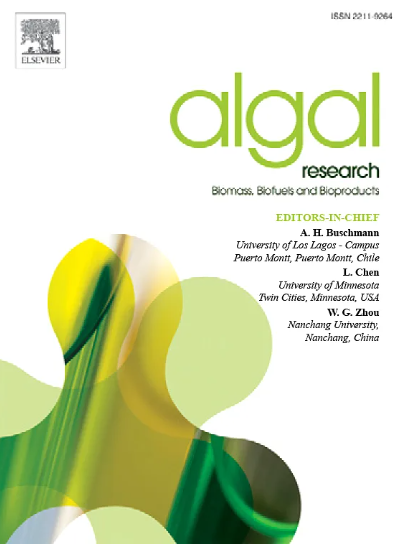利用采出水的集成微藻生物炼制:同时获得生物质、生物燃料和胞外多糖
IF 4.5
2区 生物学
Q1 BIOTECHNOLOGY & APPLIED MICROBIOLOGY
Algal Research-Biomass Biofuels and Bioproducts
Pub Date : 2025-06-14
DOI:10.1016/j.algal.2025.104140
引用次数: 0
摘要
采出水(PW)是石油工业的一种废物,可以整合到微藻生物炼制系统中,不仅可以用于生物修复,还可以用于生产与工业相关的生物分子,从而支持循环经济。因此,在PW浓度为0%至100%的培养基中,对几种微藻进行了生长试验,包括褐绿藻、zoofingiensis小球藻、griffithmonoraphidium(淡水)、Dunaliella tertiolecta、Isochrysis galbana和Phaeodactylum tricornutum(海洋)。50%的PW浓度支持微藻生长,其中在PW80% (1.58 g L−1)时观察到的galbana生物量最高。其中,三叶草(D. tertiolecta)的脂质含量最高,为37.26% (PW80%),而C. braunii的碳水化合物含量最高,为24.51% (PW50%)。在PW中生产的生物柴油显示出与在标准培养基中获得的生物柴油相当的脂肪酸谱,具有与市售生物柴油相似的特征,突出了PW作为生物炼制过程底物的潜力。测试的微藻产生的生物乙醇的数量也超过了文献中在标准培养基中培养的生物乙醇的数量(0.60-16.81 mL)。在PW中的培养也导致了大量的胞外多糖的产生,特别是I. galbana,在PW80%的条件下,其产量为0.56 g L−1。该物种还表现出很高的生物修复效率,在PW80%培养基中完全去除磷和硝酸盐,并将铁浓度降低了88%。这些结果证明了利用PW进行微藻培养和同时生产生物燃料和EPS的技术可行性,同时也支持有效的废物生物修复。本文章由计算机程序翻译,如有差异,请以英文原文为准。

Integrated microalgae biorefinery using produced water: Simultaneous obtaining of biomass, biofuels and exopolysaccharides
Produced water (PW), a waste product of the oil industry, can be integrated into microalgae biorefinery systems not only for its bioremediation but also for the production of industrially relevant biomolecules, supporting the circular economy. Accordingly, the growth of microalgal species Chlorolobion braunii, Chlorella zofingiensis, Monoraphidium griffithii (freshwater), Dunaliella tertiolecta, Isochrysis galbana, and Phaeodactylum tricornutum (marine) was tested in media containing PW concentrations from 0 % to 100 %. PW concentrations >50 % supported microalgae growth, with the highest biomass production observed for I. galbana at PW80% (1.58 g L−1). Among the tested species, D. tertiolecta exhibited the highest lipid content at PW80% (37.26 %), while C. braunii showed the highest carbohydrate content at PW50% (24.51 %). The biodiesel produced in PW exhibited a fatty acid profile comparable to that obtained in the standard medium, with characteristics similar to those of commercially available biodiesel, highlighting the potential of PW as a substrate for biorefinery processes. The tested microalgae also produced bioethanol in quantities exceeding those reported in the literature for cultures grown in the standard medium (0.60–16.81 mL). Cultivation in PW also led to substantial production of exopolysaccharides, particularly by I. galbana, which yielded 0.56 g L−1 at PW80%. This species also demonstrated high bioremediation efficiency, achieving complete removal of phosphorus and nitrate and reducing iron concentrations by >88 % in the PW80% medium. These results demonstrate the technical feasibility of using PW for microalgae cultivation and the concurrent production of biofuels and EPS while also supporting effective waste bioremediation.
求助全文
通过发布文献求助,成功后即可免费获取论文全文。
去求助
来源期刊

Algal Research-Biomass Biofuels and Bioproducts
BIOTECHNOLOGY & APPLIED MICROBIOLOGY-
CiteScore
9.40
自引率
7.80%
发文量
332
期刊介绍:
Algal Research is an international phycology journal covering all areas of emerging technologies in algae biology, biomass production, cultivation, harvesting, extraction, bioproducts, biorefinery, engineering, and econometrics. Algae is defined to include cyanobacteria, microalgae, and protists and symbionts of interest in biotechnology. The journal publishes original research and reviews for the following scope: algal biology, including but not exclusive to: phylogeny, biodiversity, molecular traits, metabolic regulation, and genetic engineering, algal cultivation, e.g. phototrophic systems, heterotrophic systems, and mixotrophic systems, algal harvesting and extraction systems, biotechnology to convert algal biomass and components into biofuels and bioproducts, e.g., nutraceuticals, pharmaceuticals, animal feed, plastics, etc. algal products and their economic assessment
 求助内容:
求助内容: 应助结果提醒方式:
应助结果提醒方式:


